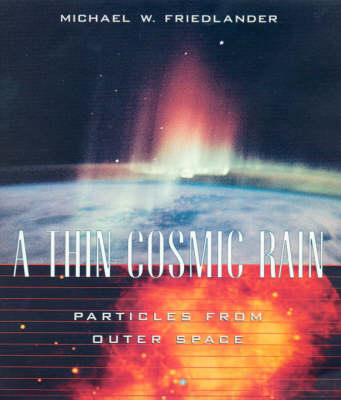
A Thin Cosmic Rain
Particles from Outer Space
Seiten
2000
Harvard University Press (Verlag)
978-0-674-00288-3 (ISBN)
Harvard University Press (Verlag)
978-0-674-00288-3 (ISBN)
- Titel ist leider vergriffen;
keine Neuauflage - Artikel merken
The story of the discovery and study of cosmic rays, from particle physics in the 1890s to modern astrophysics. This book relates the history of cosmic ray science, explains how the rays are identified and surveys the knowledge and theories of cosmic rain.
Cosmic rays - even the name conjures up a vision of otherworldly mystery. Enigmatic for many years, they are now known to be not rays at all, but particles, the nuclei of atoms, raining down continually on the earth, where they can be detected throughout the atmosphere and sometimes even thousands of feet underground. This book tells the long-running detective story behind the discovery and study of cosmic rays, a story that stretches from the early days of subatomic particle physics in the 1890s to the frontiers of high-energy astrophysics today. Writing for the amateur scientist and the educated general reader, Michael W. Friedlander, a cosmic ray researcher, relates the history of cosmic ray science from its accidental discovery to its present status. He explains how cosmic rays are identified and their energies measured, then surveys our current knowledge and theories of this thin cosmic rain.
The most thorough, up-to-date and readable account of these intriguing phenomena, his book makes us party to the search into the nature, behaviour and origins of cosmic rays - and into the sources of their enormous energy, sometimes hundreds of millions times greater than the energy achievable in the most powerful earthbound particle accelerators. As this search led unexpectedly to the discovery of new particles such as the muon, pion, kaon and hyperon, and as it reveals scenes of awesome violence in the cosmos and offers clues about black holes, supernovas, neutron stars, quasars and neutrinos, we see clearly why cosmic rays remain central to an astonishingly diverse range of research studies on scales infinitesimally small and large. Attractively illustrated, engagingly written, this is a fascinating inside look at a science at the centre of our understanding of our universe.
Cosmic rays - even the name conjures up a vision of otherworldly mystery. Enigmatic for many years, they are now known to be not rays at all, but particles, the nuclei of atoms, raining down continually on the earth, where they can be detected throughout the atmosphere and sometimes even thousands of feet underground. This book tells the long-running detective story behind the discovery and study of cosmic rays, a story that stretches from the early days of subatomic particle physics in the 1890s to the frontiers of high-energy astrophysics today. Writing for the amateur scientist and the educated general reader, Michael W. Friedlander, a cosmic ray researcher, relates the history of cosmic ray science from its accidental discovery to its present status. He explains how cosmic rays are identified and their energies measured, then surveys our current knowledge and theories of this thin cosmic rain.
The most thorough, up-to-date and readable account of these intriguing phenomena, his book makes us party to the search into the nature, behaviour and origins of cosmic rays - and into the sources of their enormous energy, sometimes hundreds of millions times greater than the energy achievable in the most powerful earthbound particle accelerators. As this search led unexpectedly to the discovery of new particles such as the muon, pion, kaon and hyperon, and as it reveals scenes of awesome violence in the cosmos and offers clues about black holes, supernovas, neutron stars, quasars and neutrinos, we see clearly why cosmic rays remain central to an astonishingly diverse range of research studies on scales infinitesimally small and large. Attractively illustrated, engagingly written, this is a fascinating inside look at a science at the centre of our understanding of our universe.
| Erscheint lt. Verlag | 17.11.2000 |
|---|---|
| Zusatzinfo | 43 halftones, 30 line illustrations, 7 tables |
| Verlagsort | Cambridge, Mass |
| Sprache | englisch |
| Maße | 178 x 203 mm |
| Gewicht | 630 g |
| Themenwelt | Sachbuch/Ratgeber ► Natur / Technik ► Weltraum / Astronomie |
| Naturwissenschaften ► Physik / Astronomie ► Astronomie / Astrophysik | |
| Naturwissenschaften ► Physik / Astronomie ► Hochenergiephysik / Teilchenphysik | |
| ISBN-10 | 0-674-00288-1 / 0674002881 |
| ISBN-13 | 978-0-674-00288-3 / 9780674002883 |
| Zustand | Neuware |
| Informationen gemäß Produktsicherheitsverordnung (GPSR) | |
| Haben Sie eine Frage zum Produkt? |
Mehr entdecken
aus dem Bereich
aus dem Bereich
die Suche nach der Urkraft des Universums
Buch | Hardcover (2023)
Klett-Cotta (Verlag)
CHF 34,95
auf der Suche nach neuen Planeten und außerirdischem Leben
Buch | Hardcover (2024)
Droemer (Verlag)
CHF 33,55


